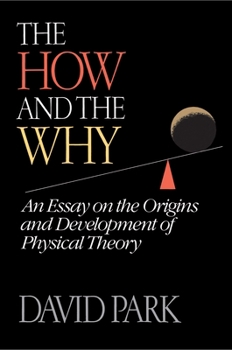The How and the Why
Select Format
Select Condition 
Book Overview
The description for this book, The How and the Why, will be forthcoming. This description may be from another edition of this product.
Format:Hardcover
Language:English
ISBN:0691084920
ISBN13:9780691084923
Release Date:September 1988
Publisher:Princeton University Press
Length:530 Pages
Weight:1.92 lbs.
Customer Reviews
1 rating
The Pleasure of Enjoying a marvelous review of history of scientific achievements
Published by Thriftbooks.com User , 14 years ago
"One unifying idea in the diversity that follows is the idea of form. ... Just as in the old days, modern scientific explanations represent experience but do not ordinarily describe it. They aim at generality and also at formal clarity." Introduction to the book New decade starter Review: I tried to figure out what book would be an engaging read to start with the second decade of the third millennium! "The How and the Why," is a marvelous review of history of scientific achievements through centuries of human ascent, fit to stimulate readers interest and intellect. A winner of the 1989 Beta Kappa award in Science, a nostalgic reminder of "How and Why Wonder Books," written mostly between 1960 and early 70's, whose fans were young people, who grew with the Kennedy space vision, when President Kennedy challenged the nation to land a man on the moon within a decade. It was one of the most historic events for America, demonstrating what man can do with determination, hard work and ingenuity, exactly what we need in 2010, to pull ourselves out of our current concerns. A brief introduction: David Park wrote a series of inspiring essays on the origins and development to fruition of physical theory, an engaging philosophy of science or an intellectual history of the advances of physical theory which landed us on the moon in 1969. Throughout the enjoyable tour of the history of physical sciences, conducted by the skillful author, introducing you to the progress of ideas and thought from Almagest all the way to Wittgenstein, in an uninterrupted discourse from "What is the World," to "And Now the Universe." Be sure not to skip the five page introduction; "What is science anyhow? ... How can we talk about what it is? All right, let us talk about the part of it that deals with the nature of the universe and of matter." Revision notes: Professor Park is a true Ph.D., a teaching philosopher, who gives a boost to the A+ readers. Order and Law is his closing chapter quoting the wise, asking, "What has been accomplished," in Simplicity, Symmetry, Causality, Determinism, Chance, and Necessity: Understanding? Revision Note A; Hero's Principle, B: Fermat's Principle, M: Theory of the expanding universe! Brickman's drawings and art selection proves the power of relevant historical imagination, "The marvel is no marvel" is wonderful (Fig 10.6), "A medieval perpetual-motion machine" (Fig 10.7) is so simply beautiful, with an old comment, "Amen dico, I say Amen" Constructive proof of Pythagorean theorem is so simple. My favorite is "The Creation" a thirteenth century illumination, a variant of the popular depiction of Genesis. Depth in variety: The proof of depth I conduct for my readings of such wide spectrum subject treatment is through index examination. Here what I found on seventh century Alexandrine thinkers; Lady Hypatia (pp.80), john Philoponus first author of impetus theory, on falling bodies dynamics (pp. 140, 204, 226) who was read by Galileo, and





